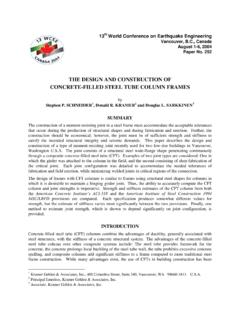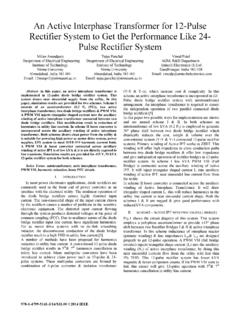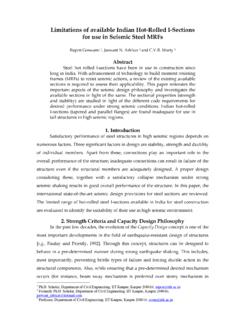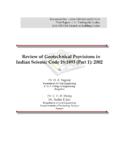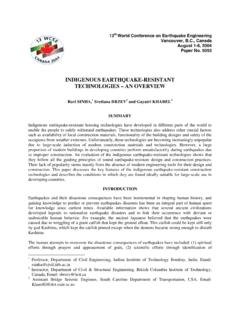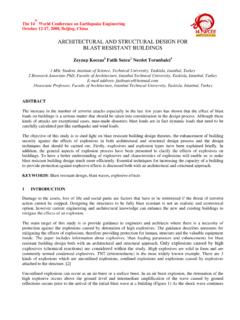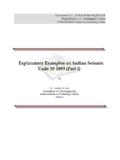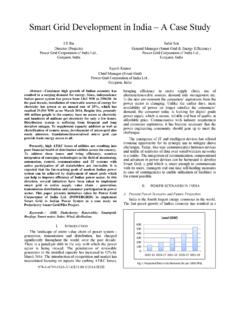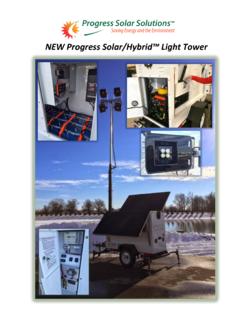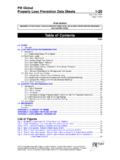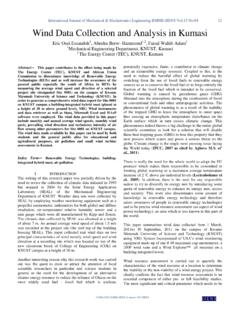Transcription of ACTIVE, SEMI-ACTIVE AND HYBRID CONTROL OF …
1 28341 Dept of Civil, Structural and Environmental Eng, State University of New York, New York, of Civil Eng and Geological Sciences, University of Notre Dame, Indiana, USA Email: SEMI-ACTIVE AND HYBRID CONTROL OF STRUCTUREST T SOONG1 And B F SPENCER, JR2 SUMMARYIn recent years, considerable attention has been paid to research and development of passive andactive structural CONTROL devices, with particular emphasis on alleviation of wind and seismicresponse of buildings and bridges. In both areas, serious efforts have been undertaken to developthe structural CONTROL concept into a workable technology, and today we have many such devicesinstalled in a wide variety of focus of this state-of-the-art paper is on active, SEMI-ACTIVE and HYBRID structural CONTROL withseismic applications.
2 These systems employ controllable force devices integrated with sensors,controllers and real-time information processing. This paper includes a brief historical outline oftheir development and an assessment of the state-of-the-art and state-of-the-practice of thisexciting, and still evolving, technology. Also included in the discussion are their advantages andlimitations in the context of seismic design and retrofit of civil engineering , SEMI-ACTIVE and HYBRID structural CONTROL systems are a natural evolution of passive CONTROL technologiessuch as base isolation and passive energy dissipation.
3 The possible use of active CONTROL systems and somecombinations of passive and active systems, so called HYBRID systems, as a means of structural protection againstwind and seismic loads has received considerable attention in recent years. Active/ HYBRID CONTROL systems areforce delivery devices integrated with real-time processing evaluators/controllers and sensors within thestructure. They act simultaneously with the hazardous excitation to provide enhanced structural behavior forimproved service and safety. Remarkable progress has been made over the last twenty years.
4 The First andSecond World Conferences on Structural CONTROL held in 1994 [Housner et al, 1994b] and 1998 [Kobori et al,1998], respectively, attracted over 700 participants from 17 countries and demonstrated the worldwide interest instructural CONTROL . As will be discussed in the following sections, research to date has reached the stage whereactive systems have been installed in full-scale structures. Active systems have also been used temporarily inconstruction of bridges or large span structures ( , lifelines, roofs) where no other means can provide rapid growth of research interest and development of active/ HYBRID structural CONTROL systems is in part dueto several coordinated research efforts, largely in Japan and US, marked by a series of milestones listed in Table1.
5 Indeed, the most challenging aspect of active CONTROL research in civil engineering is the fact that it is anintegration of a number of diverse disciplines, some of which are not within the domain of traditional civilengineering. These include computer science, data processing, CONTROL theory, material science, sensingtechnology, as well as stochastic processes, structural dynamics, and wind and earthquake engineering. Thesecoordinated efforts have facilitated collaborative research efforts among researchers from diverse background andaccelerated the research-to-implementation process as one sees 1.
6 Active Structural CONTROL Research MilestonesYearEvent1989US Panel on Structural CONTROL Research(US-NSF)1990 Japan Panel on Structural Response CONTROL (Japan-SCJ)1991 Five-year Research Initiative on Structural CONTROL (US-NSF)1993 European Association for CONTROL of Structures1994 International Association for Structural Control1994 First World Conference on Structural CONTROL (Pasadena, CA, USA)1998 China Panel for Structural Control1998 Second World Conference on Structural CONTROL (Kyoto, Japan)The purpose of this paper is to provide an assessment of the state-of-the-art and state-of-the-practice of thisexciting, and still evolving, technology.
7 Also included in the discussion are some basic concepts, the types ofactive CONTROL systems being used and deployed, and their advantages and limitations in the context of seismicdesign and retrofit of civil engineering , HYBRID AND SEMI-ACTIVE CONTROL SYSTEMSAn active structural CONTROL system has the basic configuration as shown schematically in Fig. 1c. It consists of(a) sensors located about the structure to measure either external excitations, or structural response variables, orboth; (b) devices to process the measured information and to compute necessary CONTROL force needed based on agiven CONTROL algorithm.
8 And (c) actuators, usually powered by external sources, to produce the required only the structural response variables are measured, the CONTROL configuration is referred to as feedbackcontrol since the structural response is continually monitored and this information is used to make continualcorrections to the applied CONTROL forces. A feedforward CONTROL results when the CONTROL forces are regulated onlyby the measured excitation, which can be achieved, for earthquake inputs, by measuring accelerations at thestructural base. In the case where the information on both the response quantities and excitation are utilized forcontrol design, the term feedback-feedforward CONTROL is used [Suhardjo et al, 1990].
9 To see the effect of applying such CONTROL forces to a linear structure under ideal conditions, consider a buildingstructure modeled by an n-degree-of-freedom lumped mass-spring-dashpot system. The matrix equation ofmotion of the structural system can be written as)()()()()(tttttEfDuKxxCxM+=++!!! (1)where M, C and K are the n n mass, damping and stiffness matrices, respectively, x(t) is the n-dimensionaldisplacement vector, the m-vector f(t) represents the applied load or external excitation, and r-vector u(t) is the28343 ExcitationStructureResponseExcitationRes ponseStructureSensorsExcitationResponseS tructureControllerSensorsControlActuator sPEDF igure 1c: Structure with Active ControlFigure 1b: Structure with Passive Energy DissipationFigure 1: Structure with Various CONTROL SchemesFigure 1a.
10 Conventional Base Structure28344 ExcitationSensorsResponseStructureContro llerSensorsControlActuatorsFigure 1d: Structure with HYBRID ControlFigure 1 (cont.): Structure with Various CONTROL SchemesPEDE xcitationStructureResponsePEDS ensorsControlActuatorsControllerSensorsF igure 1e: Structure with SEMI-ACTIVE Control28345applied CONTROL force vector. The n r matrix D and the n m matrix E define the locations of the action of thecontrol force vector and the excitation, respectively, on the that the feedback-feedforward configuration is used in which the CONTROL force u(t) is designed to be alinear function of measured displacement vector x(t), velocity vector )(tx!

